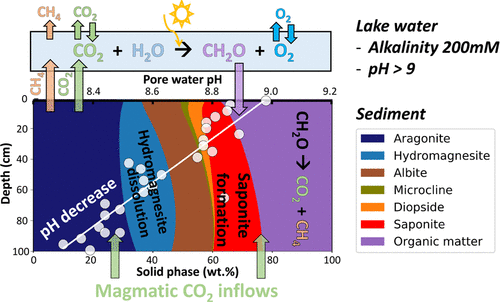当前位置:
X-MOL 学术
›
ACS Earth Space Chem.
›
论文详情
Our official English website, www.x-mol.net, welcomes your
feedback! (Note: you will need to create a separate account there.)
Early Diagenesis of Lacustrine Carbonates in Volcanic Settings: The Role of Magmatic CO2 (Lake Dziani Dzaha, Mayotte, Indian Ocean)
ACS Earth and Space Chemistry ( IF 2.9 ) Pub Date : 2020-02-25 , DOI: 10.1021/acsearthspacechem.9b00279 Vincent P. Milesi 1 , Mathieu Debure 2 , Nicolas C. M. Marty 2 , Manuela Capano 3 , Didier Jézéquel 1 , Carl Steefel 4 , Virgile Rouchon 5 , Patrick Albéric 6 , Edouard Bard 3 , Gérard Sarazin 1 , François Guyot 7 , Aurélien Virgone 8 , Éric C. Gaucher 8 , Magali Ader 1
ACS Earth and Space Chemistry ( IF 2.9 ) Pub Date : 2020-02-25 , DOI: 10.1021/acsearthspacechem.9b00279 Vincent P. Milesi 1 , Mathieu Debure 2 , Nicolas C. M. Marty 2 , Manuela Capano 3 , Didier Jézéquel 1 , Carl Steefel 4 , Virgile Rouchon 5 , Patrick Albéric 6 , Edouard Bard 3 , Gérard Sarazin 1 , François Guyot 7 , Aurélien Virgone 8 , Éric C. Gaucher 8 , Magali Ader 1
Affiliation

|
Lacustrine carbonates formed in rift settings are increasingly studied not only as archives of Earth chemical and climatic history but also as potential hydrocarbon source rocks and/or reservoirs. The role of magmatic gases in their formation and diagenetic evolution, hence in their reservoir properties, remains unclear. We studied the first meter of carbonate sediment of the Dziani Dzaha volcanic crater lake (Mayotte Island) and developed a reactive-transport model with CrunchFlow software that allows the quantification of diagenetic reactions by considering depth-dependent burial rates and sediment compaction. The model is constrained by the previously documented solid-phase compositions of the lake sediment and new data consisting of 14C dating of plant macroremains to characterize the sediment age model, chemical composition of sediment pore waters, and chemical and isotopic composition of gases dissolved and bubbling through the lake. These new data reveal a massive magmatic CO2 contribution to the dissolved inorganic carbon of the lake, which fuels the primary productivity and carbonate formation. A pH value of 9 in the surface sediment pore waters induces supersaturation relative to aragonite, hydromagnesite, and saponite. At 1 m depth in the sediment, our model predicts that magmatic CO2 inflows and organic matter degradation account for 22 and 2 mol % dissolved inorganic carbon, respectively. The magmatic CO2 inflows result in a pH decrease at depth, leading to the destabilization of hydromagnesite, while saponite and aragonite remain stable. These results demonstrate the role of magmatic CO2 in fueling carbonate production and controlling the diagenetic evolution of sediment mineralogy.
中文翻译:

火山环境中湖相碳酸盐岩的早期成岩作用:岩浆CO 2的作用(印度洋马约特岛Dziani Dzaha湖)
在裂谷环境中形成的Lacustrine碳酸盐不仅作为地球化学和气候历史的档案,而且作为潜在的烃源岩和/或储层,都得到了越来越多的研究。尚不清楚岩浆气体在其形成和成岩演化中的作用,因此在其储层性质中的作用尚不清楚。我们研究了Dziani Dzaha火山火山口湖(马约特岛)的第一米碳酸盐沉积物,并使用CrunchFlow软件开发了反应性运输模型,该模型可以通过考虑深度依赖的埋藏速率和沉积物压实来量化成岩反应。该模型受先前记录的湖泊沉积物固相成分和包含14个新数据的约束通过对植物宏观温度进行定年,可以表征沉积物年龄模型,沉积物孔隙水的化学成分以及溶解和冒泡通过湖泊的气体的化学和同位素成分。这些新数据揭示了岩浆CO 2对湖泊溶解的无机碳的巨大贡献,这为初级生产力和碳酸盐的形成提供了燃料。相对于文石,水菱镁矿和皂石,地表沉积物孔隙水中的pH值为9会引起过饱和。在沉积物的1 m深度处,我们的模型预测岩浆CO 2流入和有机物降解分别占溶解无机碳的22和2 mol%。岩浆CO 2流入会导致pH值在深处降低,从而导致菱镁矿不稳定,而皂石和文石保持稳定。这些结果证明了岩浆CO 2在促进碳酸盐生产和控制沉积物矿物学成岩作用中的作用。
更新日期:2020-02-25
中文翻译:

火山环境中湖相碳酸盐岩的早期成岩作用:岩浆CO 2的作用(印度洋马约特岛Dziani Dzaha湖)
在裂谷环境中形成的Lacustrine碳酸盐不仅作为地球化学和气候历史的档案,而且作为潜在的烃源岩和/或储层,都得到了越来越多的研究。尚不清楚岩浆气体在其形成和成岩演化中的作用,因此在其储层性质中的作用尚不清楚。我们研究了Dziani Dzaha火山火山口湖(马约特岛)的第一米碳酸盐沉积物,并使用CrunchFlow软件开发了反应性运输模型,该模型可以通过考虑深度依赖的埋藏速率和沉积物压实来量化成岩反应。该模型受先前记录的湖泊沉积物固相成分和包含14个新数据的约束通过对植物宏观温度进行定年,可以表征沉积物年龄模型,沉积物孔隙水的化学成分以及溶解和冒泡通过湖泊的气体的化学和同位素成分。这些新数据揭示了岩浆CO 2对湖泊溶解的无机碳的巨大贡献,这为初级生产力和碳酸盐的形成提供了燃料。相对于文石,水菱镁矿和皂石,地表沉积物孔隙水中的pH值为9会引起过饱和。在沉积物的1 m深度处,我们的模型预测岩浆CO 2流入和有机物降解分别占溶解无机碳的22和2 mol%。岩浆CO 2流入会导致pH值在深处降低,从而导致菱镁矿不稳定,而皂石和文石保持稳定。这些结果证明了岩浆CO 2在促进碳酸盐生产和控制沉积物矿物学成岩作用中的作用。











































 京公网安备 11010802027423号
京公网安备 11010802027423号